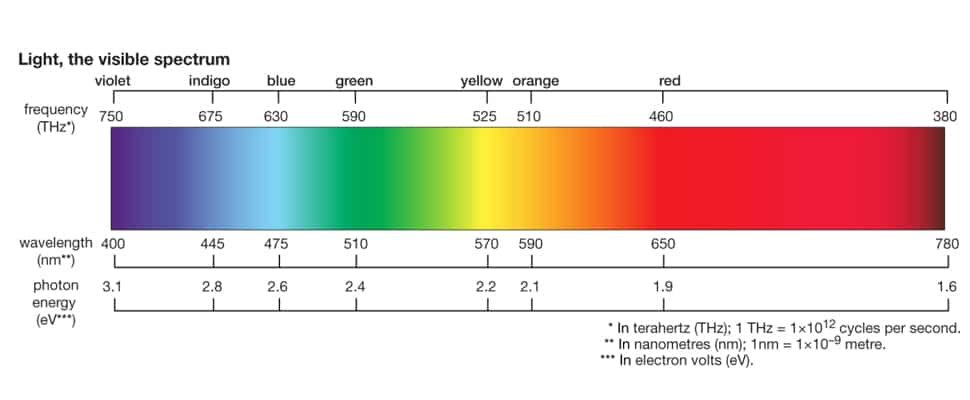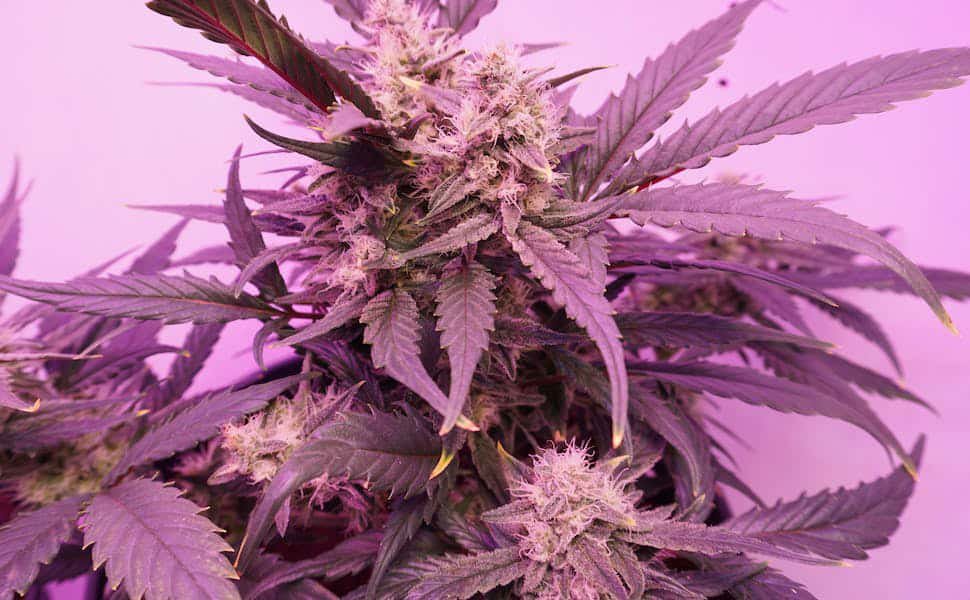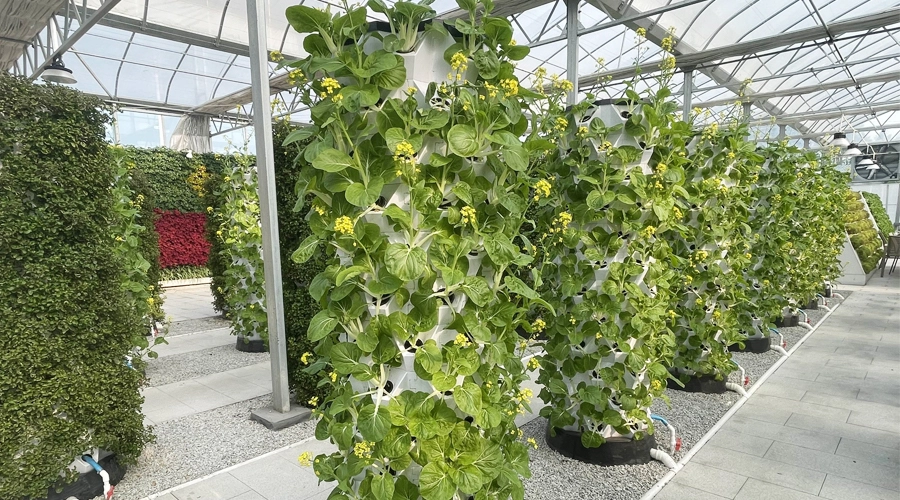Indholdsfortegnelse
We all know that light is critical to plant growth. Maybe it’s just a one-sided literal understanding, just as some novice growers fail to understand why their plants need a specific type of color light. When you start growing fruits, vegetables, and other plants indoors, you definitely want to use indoor LED grow lights to assist them to grow better as well.
We will try to explore more about the light colors that plants need for light in this article so that you can understand why the combination of blue and red wavelengths with small amounts of green, yellow, and infrared wavelengths helps photosynthesis. This helps you to be able to make an informed choice when choosing an indoor weed growing light next.

Why Do Plants Grow Towards Light?
Have you noticed that your turtleback’s new leaves are spreading out the window, or that a certain plant appears to be growing indoors when placed? Plants have developed a variety of strategies to capture the most amount of sunlight through their leaves.
This is because plants need light to carry out photosynthesis. If they do not have access to the light they need at the moment, they will naturally try to get closer to it. This ability to grow in response to light is called phototropism.
If a seed germinates and finds itself in a place with too little light, or if a plant that is already growing finds that the amount of light it needs is suddenly reduced, the plant will react in several ways:
- The stem grows longer without growing leaves, hoping to find a place where the leaves will get enough light.
- Existing leaves turn yellow as the plant is pulling out the material that makes the leaves green to conserve energy until it finds a point to justify the energy output needed to establish functional photosynthesis.
- If new leaves germinate are small and misshapen because they don’t have enough material and energy to develop properly.

It is not only limited to the plant world some fungi and bacteria also exhibit this behavior. What’s in the “light”? What does it do to the growth of plants?
Different Colors Do Various Things
The light used by plants for photosynthesis is called photosynthetically active radiation and is in the same spectrum as the indoor grow lights for herbs we can see. The different colors have their own tasks to perform. Likewise, plants use different colors of light for various purposes.
- Blue light should be used when planting seeds and when germinating for the first time. This is because blue light can increase the amount of chlorophyll formation.
- When the plants mature and start to flower, red and blue light is important, which helps them to produce more leaves and better crops.
- The higher energy emitted by violet light helps to enhance the color of plants, fruits, and vegetables.

Purple Light (380-430nm): Compared to other colors in the spectrum, violet has the shortest wavelength but relatively high energy.
Blue Light (430-500nm): It is one of the most critical light colors for plant growth.
Green Light (500-565nm): It penetrates the thick top canopy and supports the leaves of the lower canopy.
Yellow Light(565-580nm): Yellow is the most visible color in the spectrum, but it is naturally the light color least used by plants.
Orange Light(580-625nm): Like yellow, orange is the most visible color in the spectrum and does not contribute to plant development.
Red Light(625-740nm): Like blue, plants absorb red to aid photosynthesis.
Far Red (740-1050nm): Far infrared or infrared (IR) is the longest wavelength in the visible light spectrum.
UV Light: The high energy of UV radiation may burn plants. However, there are some benefits to cannabis cultivation.
But can we adjust or enhance the amount of light we provide to make our plants grow faster and healthier?
The answer is yes, and that’s precisely why plant grow lights indoor exist.
If you want to know whether plants grow better in sunlight or in artificial light, we are preparing a whole article about it.
Best Color Light Depends on Your Goals
All plants use a different color spectrum for their growth cycle from seedling to adult to flowering and fruiting.
That’s why the ideal indoor LED grow lights differ for each growth stage. The optimal color spectrum also depends on the type of plant you want to grow.
This can get very complicated and is really only important to commercial growers who want to maximize results. In general, plants perform best with all wavelengths of light. However, they do not need equal amounts of light, nor do they necessarily absorb all light.
What Does Purple Light Do To Plants?
All plants use a different color spectrum for their growth cycle from seedling to adult to flowering and fruiting.
In the spectrum, violet has the shortest wavelength but relatively high energy.
The higher energy emitted by violet helps to enhance the color of plants, fruits and vegetables. Combined with blue and red light, it helps plants to acquire their color and aroma. In addition, it also helps to enhance the amount of flavor and antioxidants in the plant stems.

Does Blue Light Help Plants Grow?
Blue is a cool color and is one of the most critical light colors for plant growth.
It is readily absorbed by chlorophyll in the short wavelength range between 430-500nm. Although it is an effective light color for photosynthesis, it is only more effective for plant growth when combined with red.
In addition, plants that absorb blue light quickly are usually more compact and thicker, and the dark green leaves prevent slender stems from growing.
Is Green Light Good For Plants?
Green is considered to be the least effective light color for plant growth. However, green wavelengths penetrate more deeply into the photoreceptor, while other wavelengths do not.
They may help plants reach their full potential. Its plant photoreceptors responsible for photosynthesis may absorb some green light for sustained growth. You should have a small amount of green light in the spectrum.
How Well Would A Plant Grow In Yellow Light?
The absorption of light yellow by plants helps the photosynthesis process, but it may not help by itself. Seedlings exposed only to yellow light do not produce carbohydrates and therefore cannot photosynthesize for growth.
Yellow light has a wavelength of about 550 – 600 nm. There are two main types of chlorophyll in plants, namely chlorophyll a and chlorophyll b.
Is Orange Light Good For Plants?
Along with yellow, orange is one of the most visible colors in the spectrum. It does not help plants much in their development. Most plants will absorb orange quickly without causing too much damage, so you don’t have to worry about limiting their intake.
Is Red Light Good For Growing Plants?
Plants mostly absorb red to help with photosynthesis. However, it may not be effective on its own and can better assist in effective plant growth when combined with blue light. Used in combination with blue wavelengths, generally, in the 5:1 range, it works wonders for increasing leaves and flowers.
Red light is very effective in regulating plant growth and development, helping flowering and fruiting and prolonging the flowering period. However, plants grown only under red light may develop a stretched, elongated appearance and undesirable thin leaves. The general indoor LED grow lights’ spectrum is mainly red light combined with blue light.
Does Plants Like Far Red Light?
This is the longest wavelength in the visible light spectrum.
It contributes to the seedling or germination process, where infrared light signals seedlings to start germination and shorten the time it takes for plants to flower. Far-red light also passes through the dense upper canopy to support leaf growth at the bottom of the plant.
How Does UV Light Affect Plants?
Just as humans are sensitive to UV radiation, UV light can affect plants as well. The high energy of UV radiation can quickly burn the leaves and stems of plants.
But UV light has some benefits. Exposure of cannabis to UV light stimulates the production of resins, oils, and protective antioxidants to protect against harmful rays, which provide additional flavor.
Mange LED plant light manufacturers are now developing full spectrum indoor grow lights with UV light, specifically designed for cannabis growers.
Konklusion
There is no real answer to the question of which light color is more suitable for plant growth. Each type of light has its own meaning, they can all have a positive impact on plants at all stages of growth.
- The combination of red and blue light is very conducive to good plant growth.
- The effect of blue light on plants is directly related to the production of chlorophyll. It controls the flow of chloroplasts in the cells and plants that receive a lot of blue light will have strong, healthy stems and leaves.
- Red light is responsible for causing plants to flower and produce fruit. It helps increase biomass and is also essential for the early life of the plant for seed germination, root growth and bulb development.
Jayes
Som Digital Marketing Manager hos AUXGROW kombinerer Jayes en passion for hydroponiske systemer og ekspertise inden for LED vækstlys. Med praktisk erfaring og en dyb forståelse guider Jayes dig gennem verden af bæredygtig dyrkning.





